An object thrown at a certain angle to the ground moves in a curved path and falls back to the ground. The initial and the final points of the path object lie on the same horizontal line. What is the work done by the force of gravity on the object ?
The correct Answer is:Zero
To solve the problem of calculating the work done by the force of gravity on an object thrown at a certain angle to the ground, we can follow these steps:
Step 1: Understand the Motion of the Object
The object is thrown at an angle and follows a curved path (projectile motion) before returning to the ground. The initial point (A) and the final point (B) of the object's path are at the same horizontal level.
Hint: Remember that in projectile motion, the object moves up and then down, but the starting and ending heights are the same.
Step 2: Identify the Forces Acting on the Object
The primary force acting on the object during its flight is gravity, which acts downwards with a force equal to mg (where m is the mass of the object and g is the acceleration due to gravity).
Hint: The force of gravity is constant and acts vertically downward throughout the motion.
Step 3: Define Work Done by a Force
Work done by a force is calculated using the formula:
Work=Force×Displacement×cos(θ)
where θ is the angle between the force and the direction of displacement.
Hint: The direction of the force and the direction of displacement are crucial in determining the work done.
Step 4: Analyze the Displacement in the Direction of Gravity
In this case, while the object moves from point A to point B, it returns to the same vertical position (height). Thus, the vertical displacement (which is in the direction of the gravitational force) is zero.
Hint: Displacement in the direction of gravity is the change in height. If the initial and final heights are the same, the displacement is zero.
Step 5: Calculate the Work Done by Gravity
Since the vertical displacement is zero, we can substitute this into the work formula:
Work=mg×0×cos(0)=0
Thus, the work done by the force of gravity on the object is zero.
Hint: Remember that if there is no displacement in the direction of the force, the work done is always zero.
Final Answer
The work done by the force of gravity on the object is 0 Joules.
The object is thrown at an angle and follows a curved path (projectile motion) before returning to the ground. The initial point (A) and the final point (B) of the object's path are at the same horizontal level.
The primary force acting on the object during its flight is gravity, which acts downwards with a force equal to mg (where m is the mass of the object and g is the acceleration due to gravity).
Work done by a force is calculated using the formula:
Work=Force×Displacement×cos(θ)
where θ is the angle between the force and the direction of displacement.
In this case, while the object moves from point A to point B, it returns to the same vertical position (height). Thus, the vertical displacement (which is in the direction of the gravitational force) is zero.
Since the vertical displacement is zero, we can substitute this into the work formula:
Work=mg×0×cos(0)=0
Thus, the work done by the force of gravity on the object is zero.
The work done by the force of gravity on the object is 0 Joules.
Topper's Solved these Questions
Similar Questions
A force exerts an impulse Ion a particle changing its speed from initial velocity u to final velocity 2u. The applied force and the initial velocity are oppositely oriented along the same line. The work done by the force is
View SolutionA force exerts an impulse Ion a particle changing its speed from initial velocity u to final velocity 2u. The applied force and the initial velocity are oppositely oriented along the same line. The work done by the force is
View Solution
Knowledge Check
A force F acting on an object varies with distance x

The work done by the force in moving the object from x=0 to x=8 m isAzeroB80 JC−40JD40JA force F acting on an object varies with distance x as shown in the figure. The work done by the force in moving the object from x=0 to x = 20 m is
 A500 JB1000 JC1500 JD2000 J
A500 JB1000 JC1500 JD2000 JA vertical force F of strength 20 N acts on an object of mass 3 kg as it moves a horizontal distance of 4 m. the work done by the vertical force is equal to
A0JB60JC80JD600J
A mass of 10 kg is at a point A on a table. It is moved to a point B. If the line joining A and B is horizontal, what is the work done on the object by the gravitational force ? Explain your answer.
View SolutionA force F acting on an object varies with distancex as shown in figure. Work done by the force in moving the object from x = 1 m to x= 6 m is

View SolutionA force of 7N acts on an object. The displacement is, say 8m, in the direction of the force, Let us take it that the force acts on the object throughout the displacement. What is the work done in this case ?

View SolutionAn object thrown verticallly up from the ground passes the height 5 m twice in an interval of 10 s. What is its time of flight?
View SolutionAn object is pushed and pulled along a certain angle with respect to horizontal and is moved the some distance on the ground. Now the work done by frictional force will be more in

View Solution
